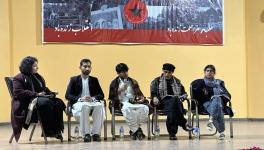Modi's Foreign Jaunts: More Shadow Little Substance
Modi has decided that the pomp and show that worked for him in Gujarat, should work for him in the foreign policy realm as well. The reality is that while Modi's media blitz won him kudos in India, Indian foreign policy gained nothing from his engagements with China and the US, and has resulted in setting the Pakistan policy back. Foreign policy requires a clear understanding of the issues, focussing on what is achievable, and back channel dialogue on contentious matters before any meeting. Instead, Modi took the high-risk path of engaging without any preparation with leaders of various countries and has come out a cropper.
One of the key elements of the so-called Gujarat Model has been Modi's ability to control the media and wipe out all opposition inside his party. There is enough evidence to show that the poor, the minorities and the women were left out his development program. But this is not the picture that the media presents to the people on Gujarat. The talk is how big capital loves Modi and Modi's Gujarat: quick clearances, big concessions to capital and how he has built good roads. It is this model that big capital wants for India; a capital friendly government with no rights for workers, the poor and the minorities.
Modi has now decided that this is the model that will work for him in foreign policy as well. His foreign policy engagements show all the elements of media victory and little substance. His performance on the three crucial engagements – Pakistan, China and the US – have not only delivered nothing but has actually set the clock back in the case of Pakistan. In all these cases, there was no serious preparation on India's foreign policy objectives. The entire exercise was one of projecting Modi and how he was being feted world over. Worse, in his anxiety to cut out Sushma Swaraj, the Minister for External Affairs, he has also cut out the foreign office and made Ajit Doval, the National Security Advisor as his sole advisor on foreign affairs. By doing this, he messed up the Pakistan initiative with Nawaz Sharif, gave an ultimatum to Xi Jinping on Ladak that backfired, and came out with empty hands in Washington.

Image Courtesy: flickr.com
First Pakistan. His initiative in asking all the SAARC heads to attend his swearing in might have been extended more in the spirit of coronation of the new Emperor, but nevertheless did open some space with Nawaz Sharif, the Pakistani Prime Minister. Without any agenda however, the thaw in India Pakistan relations was short lived and went back to deep freeze, when the Foreign Secretary level talks were called off in August. The reason given – that the Pakistani Embassy in India was holding talks with the separatist forces in Kashmir – sounds weak as everybody is aware of contacts that Pakistan maintains with Kashmiri groups. If this was a no-no for India now, this should have been conveyed as a pre-condition before announcing the talks. In other words, preparations of any serious engagement works only when the ground work is done including the do's and more importantly, the don'ts. Without such an agreed protocol, it leaves only bitterness when the talks are unable even to start.
Not surprisingly, Pakistan and India relations are not only in the cold, but the border is heating up. With Pakistan military actively working to weaken the civilian leadership and its tacit support to Imran Khan and his rag tag band, the military is signalling that Nawaz Sharif is only one of the centres of power in Pakistan. The other centre, and indeed the more powerful one is Pakistan's deep state: a combination of the military and the security forces. That is why there is a need for groundwork in India Pakistan relations; we need to have all important players on board for a peace initiative before we have can have any meaningful engagement with Pakistan. Grandstanding is no substitute for diplomacy.
Modi had also made other forays in foreign policy. One was his entirely ceremonial BRICS visit, where he did nothing of note and followed, more or less docilely, the previous governments take on BRICS. His Japan visit was an attempt to portray Abe and Modi as two politicians from the same mould. Again high on media hype and little else. The promise of billions of foreign investments mean very little – they are only “intentions” and do not produce hard cash.
Modi's real test was Xi Jinping's visit. Here was a Chinese leader, on an Indian visit, who has just assumed office. Again, Modi showed his lack of preparation, cutting out the foreign office and making it all about himself and Gujarat. India was never in the picture. And to add to his tough guy image, gave an ultimatum to Jinping to withdraw from Chumar. This backfired badly when China did not withdraw its forces till long after Jinping left, and only after discussions between the two armies' local commanders.
The Chumar face-off between the two armies – a local event – was elevated by a frenzied Indian media as the prelude to a shooting war between India and China. In the raucous debate in the TV studios, where India's foreign policy seems to be currently made, the much moustachioed retired generals were all for an immediate war, devil take the consequences. What they forgot to inform their viewers is that the Line of Actual Control between the two sides has never been fully demarcated in Ladak. The PLA and the Indian Army differ in this sector on where it actually runs. The incident that led to the stand-off is when allegedly, some civil works was being done in one of this “disputed” zones under NREGA, leading to a Chinese riposte of sending in of its troops to camp in the same zone. The Indian Army was quite clear that this “incursion” was a routine matter that would be sorted out by local commanders and was not going to turn into a shooting war, notwithstanding the hysterical predictions emanating from New Delhi's news channels.
Instead of handling this incident as a relatively minor one, Modi acceded to the demand of the 24-hour channels and issued an ultimatum to Jinping, the Chinese PM. Somebody forgot to tell him that major powers cannot be seen to be backing down when served with such ultimatums. Was Modi grandstanding knowing full well that his ultimatum was going to fall flat and people would remember only the ultimatum and not what was the Chinese response? Or did he really believe that like his opponents in Gujarat including the Congress, the Chinese would back down before his bumbling bravado? Predictably, Jinping made soothing noises but let the matters take their own course. Modi then declared victory because some Chinese provincial government signed agreements with the Gujarat state government, that too based on maps of India in which Gujarat government “conceded” parts of Arunachal Pradesh to China! A shoddy job, showing once again the paucity of preparation for Jinping visit and cutting out completely India's External Affairs Ministry in all this.
Post Jinping visit, the Indian media again hyped up the possibility of an India China regional war, based on Jinping's speech to PLA. That PLA should be capable of fighting a regional war is a policy that has been reiterated by all past Chinese leaders and is PLA's official doctrine for the last 21 years. Was it ignorance in the Indian media of such a policy or were they duped by forces that do not want friendly relations between India and China?
The US visit has been dominated by Modi's Madison Garden show and his participation in New York festival. As his supporters themselves claim, these were the high water mark of his visit. He showed “them” how much influence he wields among the Indian American community. His intervention in Global Citizen Festival in New York’s Central Park to the youth and his salutation of “may the force with you” may have appeared a hip message for the youth to his media managers but opened him to widespread ridicule.
His joint statement with Obama produced nothing of substance, except mentioning South China Sea as a trouble spot. One commentator called it an appalling document. This is signal to China that the US may be able to pull in India in its strategic orbit to contain China. This is certainly not a good signal if Modi wants to claim that he has established warm ties with China.
For the theatrics of the visit. Modi's media managers made much of his rock star performance, his 9-day Navaratra fast, his meeting CEO's, etc. Very little focus was on what transpired during his meeting with Obama and other US officials.
Modi's frenetic foreign policy “outings” has impressed many with his natty, designer bundi's; it has delivered nothing for the country. On Pakistan, it has set the clock back. Others, such as China and the US, have been missed opportunities at best. It also shows that Modi is less interested in the substance of foreign policy and more in the publicity that such visits generate. In his scheme of things, media management is the key to success. This is the Gujarat model in foreign policy. The shadow is more important than the substance.
Disclaimer: The views expressed here are the author's personal views, and do not necessarily represent the views of Newsclick
Get the latest reports & analysis with people's perspective on Protests, movements & deep analytical videos, discussions of the current affairs in your Telegram app. Subscribe to NewsClick's Telegram channel & get Real-Time updates on stories, as they get published on our website.
























